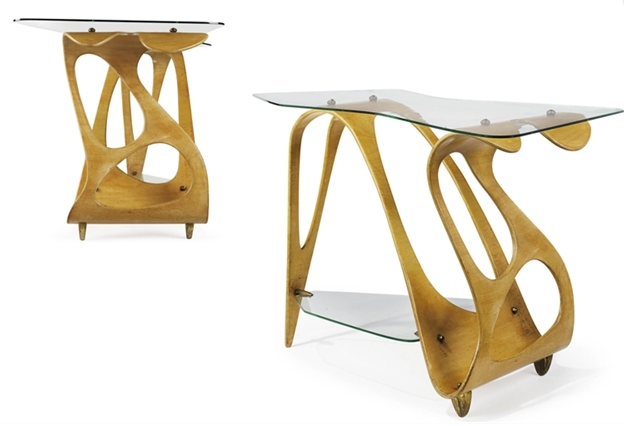Balenciaga
Robe de Mariée 'Trapèze', 1967
Carlo Mollino
Vertebra Table for the Lattes Publishing House, 1951-54
Continuity refers to a state of stability and the absence of disruption, an unbroken connection or line of development with no sharp breaks. A handful of the most original and innovative designs throughout the creative arts have explored the principles of continuity.
Parisian couturier Paul Poiret established his fashion house in 1903 despite his lack of training in tailoring, patternmaking and sewing. In lieu of technical skills, Poiret adapted alternative methods to facilitate his elaborate designs. In 1919 he developed his famed “Paris” coat, which was constructed using a single piece of fifteen-foot silk velvet that had been twisted and draped into shape without a cut or stitch, aside from one continuous seamline to shape the entire garment; a true early-twentieth century feat of modern construction and structural simplicity.
In 1947, Salvatore Ferragamo, an Italian pioneer in the art of accessory design, launched his now famous “Invisible Sandal”. Never one to shy away from non-traditional materials, Ferragamo’s “Invisible Sandal” was constructed out of one continuous piece of nylon monofilament (fishing line) that is woven through tiny holes in the insole of the shoe to form the upper portion of the sandal. What appear at first glance to be countless tiny clear strings is in fact one single nylon wire.
Paul Poiret
'Paris' Coat - 1919
Salvatore Ferragamo
Invisible Sandal, 1947
Just over a decade later in 1961, the Spanish maestro of couture Cristóbal Balenciaga unveiled his “One Seam Coat”. The designer’s artful use of darts and folds results in a modernist masterpiece of outerwear using as few seams as structurally possible. Balenciaga expanded on this technique in 1967 with the design of his “Robe de Mariée ‘Trapèze’”, a single-seam wedding dress made of heavy gazar creating a perfectly draped, minimal design. A truly remarkable example of continuity and ingenuity wrapped up in a single, complex garment.
Balenciaga
One Seam Coat, 1961
Doris Kleiner in Balenciaga
Photography by Bert Stern for British Vogue, 1964
Balenciaga
Robe de Mariée ‘Trapèze’, 1967
In 1976, Halston took a similar approach to construction in the making of his “Sarong” dress. The American designer used a single piece of carefully cut fabric draped on the bias with intricate folds and a sarong-like closure resulting in a perfectly constructed dress with one lone seam swirling around the body like a spiral.
Halston
Sarong Dress, 1976
Halston
Sarong Dress Closure, 1976
In the same era that Salvatore Ferragamo was experimenting with single strands of fishing wire, architect Carlo Mollino, a fellow Italian, was engineering complex furniture designs using maple plywood. A number of Mollino’s most glorified tables are cut and curved into shape from one continuous piece of wood, resulting in true masterworks of structural ingenuity.

Carlo Mollino
Arabesco Coffee Table, 1949
A discussion on continuity in the visual arts would fall short without mention of Pablo Picasso’s single line drawings (“One Liners”); a compact and playful series from the latter half of the artist’s prolific career. The subjects of these whimsical works range from simple animals and ring-shaped harlequins, to complex music and circus scenes. Whether the artist used pen, pencil, paintbrush or crayon, the featured drawing implement was not lifted once it touched the paper until the work was complete. Creating highly complex, uninterrupted scenes of pure artistic bliss.


